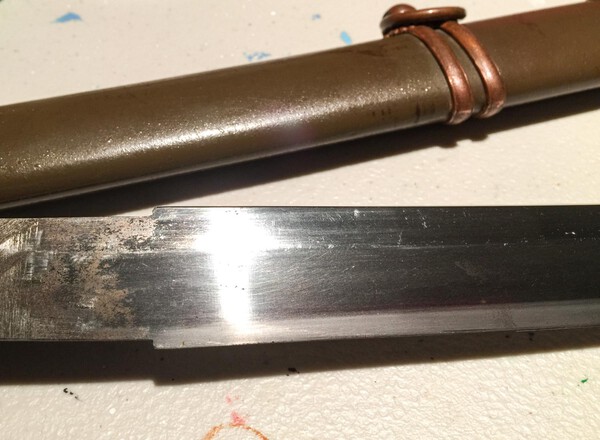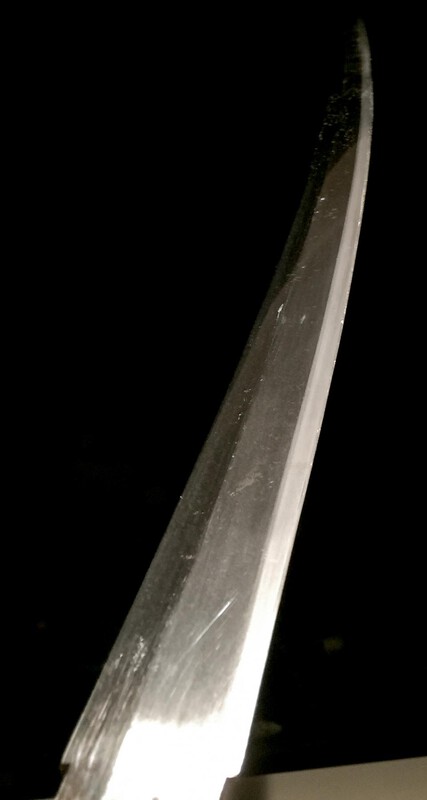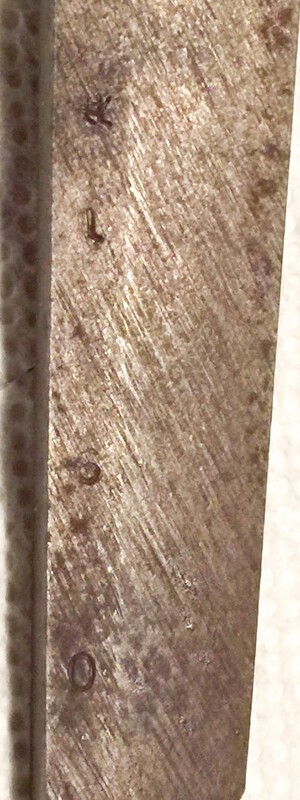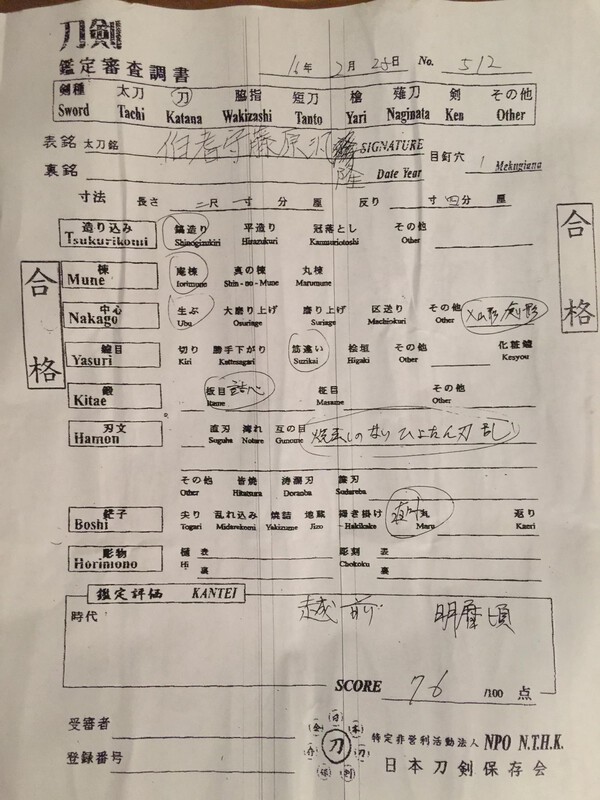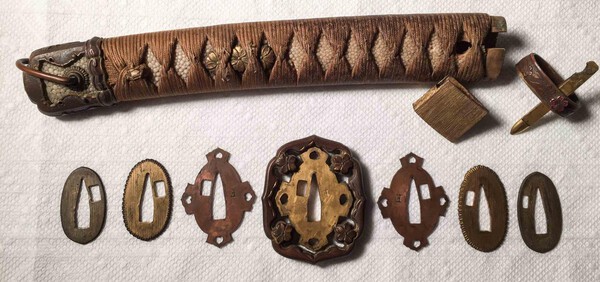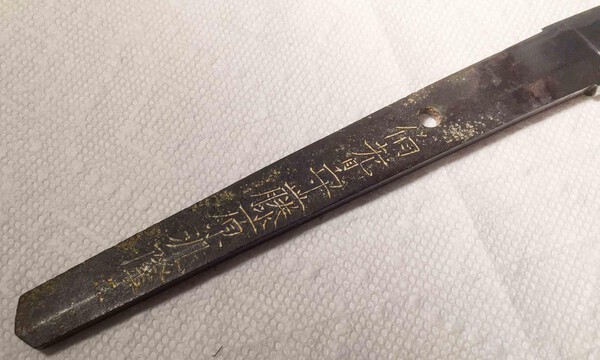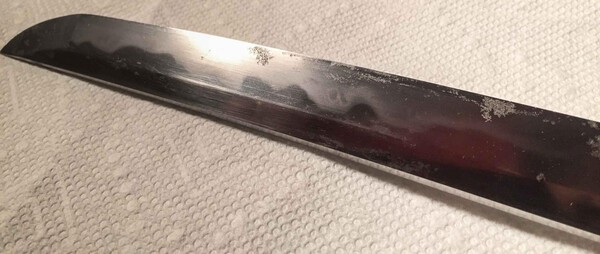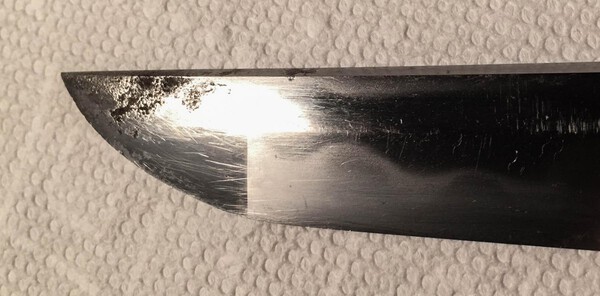-
Posts
123 -
Joined
-
Last visited
-
Days Won
2
Content Type
Profiles
Forums
Events
Store
Downloads
Gallery
Everything posted by Okiiimo
-
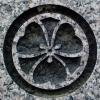
Handwriting Decipher On Nthk Kanteisho Date Assistance Request
Okiiimo replied to Okiiimo's topic in Translation Assistance
-
I'm trying to decipher an era judgement on an NTHK kanteisho and a particular character has me stumped (curled in red). I believe the first character is "ei" and the last is "goro". My three guesses are ko, wa or sho but all the characters seem to require artistic interpretation to make the text kanji fit the handwriting. Am I in the ballpark? Thank you!
-

How Many Vintage Swords Still Exist?
Okiiimo replied to Vermithrax16's topic in General Nihonto Related Discussion
I can't speak to the greater tabulated numbers but can offer a single example of the Japanese perception of sword laws and a single example of non-registered blades. Sometimes I think people over generalize Japanese culture. My Japanese uncle inherited the my grandfathers household. When I visited back in 2000, I have asked to see my grandfathers sword which where long rumored to exist. They were hidden away deep in a closet under a stack of futons. He was terrified of them and under the impression they were outright illegal to own. He said he wanted to donate them to a museum but I think he's too afraid of even take them out of the house. My point is, not all Japanese are fully aware of the sword laws, they do knowingly break them (more out of fear of public perception) and my extended family has two swords that are hidden away outside of registration. -

Seller Japaneseswordgallery
Okiiimo replied to Stephen's topic in Auctions and Online Sales or Sellers
Based on recent experience with the formentioned site, they changed their business model. They offer free listing for the first 100 listings and charge 10% commission. There is no cost to the "brokering" lister and about 90% profit margin for a sale at 100% markup. -

Tanobe Sayagaki Translation - Pls Help Me Finish!
Okiiimo replied to Okiiimo's topic in Translation Assistance
Wow Steve! Thank you for putting in so much time helping me with this. I truly appreciate it! The first step I took in attempting this translation was trying to understand Tanobe-san's handwriting by finding the corresponding kanji text. From the text, I figured it would be a simple matter of searching the internet by cut & paste for the kanji meaning (it turns out it's not quite that simple!). Handwriting made it difficult for me to even guess at the text kanji, trying to figure out the stroke count and appropriate radicals are obscured to my untrained eye - made it difficult, if not impossible to go from handwriting directly to a translator. Also, to answer your question about which type of writing I was trying to use (hiragana vs katagana) - I wasn't aware I was interchanging the kanji systems. In trying to find the kanji text match to the handwriting I was dependant on translated examples available on the internet. The sources probably used different kanji systems which in my cutting and pasting, I wasn't aware of the kanji system the information source was using. Prior to going through this exercise, I knew nothing about kanji and the Japanese writing. Now, I understand how big that nothing really is. I've got a lot to learn and I thank you very much for guiding me on this first step. The final pdf of the translation is attached. 20170402_GassanTanobeSagayakiTranslation.pdf -

Tanobe Sayagaki Translation - Pls Help Me Finish!
Okiiimo replied to Okiiimo's topic in Translation Assistance
Steve - Thank you for the last round of corrections and edits! Brian - Thanks for making such a thing possible by running this forum! I think I'm pretty close to calling it done. One thing I've learned from this exercise (and I've learned a lot) is that there seems to be a fair amount of interpretive license when going from a literal translation of Japanese to narrative English. I'm sure there are errors in the final narrative and I hope I'm close. Photos of the blade in question are attached as well. Thanks all! *draft Final* 1) 出羽 国 月山 Dewa kuni Gassan Dewa province Gassan 2) 但 薙刀 直し 無銘 也 同派 ノ 特色 十ル 綾杉 肌 ノ 鍛錬 ヲ 顕示し 焼刃 共二 鄙ぶる 風情 Tadashi naginata naoshi mumei nari dôha no tokushoku naru ayasugi hada no tanren wo kanjishi yakiba tomoni hinaburu fuzei Although (this) halberd is modified (and) unsigned,(it has the) same school characteristics of large wavy grain (and) forged tempered edge (which) together reveals (a) rustic feeling. 3) 有 之 而 典型的 也 蓋シ 年代 八 南北朝 末期 乃至 室町 初期 歟 Arimasu shikōshite tenkeiteki nari kedashi nendai wa Nanbochukô sueki naishi Muromachi shoki ka It is furthermore (in a) pattern (that is) probably typical of an era between the early Nanbochukô and late Muromachi period. 4) 刃長 壹尺 七寸 三分 有之 Hachō isshaku nanasun sanbun arimasu Edge (length) is 1 shaku, 7 sun, 3 bun. (20.6 inches / 52.4 cm) 5) 丁亥 神無月 上浣 Hinoto-I kannazuki jōkan Heisei 19 (2007) (in the) first third of the 10th month. 6) 探山 観 併 誌 + kaô Tanzan kan awasete shirusu + kaô Tanzan (art name for Tanobe Michihiro) observed and recorded (artists mark) -

Tanobe Sayagaki Translation - Pls Help Me Finish!
Okiiimo replied to Okiiimo's topic in Translation Assistance
Steve - Thank you for your help! Especially for correcting my mistakes - I think the misidentification of characters and pairing to form the words would have lead me to pit of incomprehensibility. I've added the new information to my translation worksheet and will begin hitting the internet dictionaries to complete defining the words. Here's what I have so far... ps - donation sent 20170401_GassanTanobeSagayakiTranslation.pdf -

Tanobe Sayagaki Translation - Pls Help Me Finish!
Okiiimo replied to Okiiimo's topic in Translation Assistance
Thomas Thank you for your assistance. It fills in a few gaps! Here's where I'm at on the translation so far... I've copied the sayagaki photo into publisher and added the translation and text characters. The unidentified characters have question marks. I really would appreciate assistance on those! -

Tanobe Sayagaki Translation - Pls Help Me Finish!
Okiiimo replied to Okiiimo's topic in Translation Assistance
I guess I could use Mr Sesko's services. I'd thought I'd try this forum to build rapport and hopefully learn from others here as I struggle in my learning. The offer I made is a personal experiment that I thought would provide a token incentive and benefit the forum. Benefitting the forum would benefit everyone that uses it right? -
Dear compatriots, I humbly ask your assistance in reviewing my translation attempt on a Tanobe Sensei sayagaki and assisting me to finish. I’ve spent many hours attempting to identify the characters on lines 2 and 3. I think I’ve gotten about ¾ of the way there but stuck. I’ve been using translated examples of other Tanobe sayagaki and used those examples to match the script on my sayagaki. (Darcy, if you’re reading this, thank you for providing that information on your site, it’s been immensely helpful!) This matching method is tedious but it does works to limited degree. Because the descriptive language and nihonto terminology tend to carry over between Tanobe sayagaki parts tend to fall into place and makes sense - generally. I find I’m having great difficulty trying to translate the string of translated Japanese into a meaningful English sentences. I know I've got a longs ways to go, but so far, I believe I'm starting to recognize characters and being able to pick them out! If there is a kind soul or souls to help me, I ask for assistance in identifying the Tanobe script could not identify (denoted by (?)) and help me with my English translation so the sentence makes sense to an english speaker. I'm not requesting a time intensive course, but a word hint or suggestion would be very helpful as I think I'm missing the correct context that would provide the correct definition. A photo of the sayagaki in question is attached. In return, I will provide a donation $30 to NMB in the name of those individuals that have provided assistance (I hope this is OK to make such an offer, if not, please let me know and I’ll withdraw the offer.). Thank you! My translation effort thus far [unrecognized characters denoted by (?)]: 1) 出羽国月山 Dewa kuni Gassan 2) 但薙刀直し無銘也 - 同派ノ特色ナル綾杉肌ノ鍛錬ヲ (?) (?) (?) 焼刃 (?) (?) ビル (?) (?) Tadashi naginata naoshi mumei nari – Dôha no tokushoku naru ayasugi hada no o (?) (?) (?) yaki jiba (?) (?) obiru (?) (?) Although, naginata naoshi unsigned, (there is) agreement (that the) characteristic to be of use (as) ayasugi hada forging (?) (?) (?) tempered jihada and hamon (?) (?) (obiru?) (?) (?). 3) 有 之而典型的也 - 蓋シ代年八南北朝末期乃至室町 (?) 期 (?) Kore ari shika tenkei teki nari – kedashi? nendai hachi Nanbukucho maki naishi Muromachi (?) ki (?) Approximately thus type like. (kedashi?) period 8 Nanbukucho end to Muromachi (?) (ki?) (?)
-
That Aoi art site is an amazing resource! I really appreciate that they post past sales and make the information and outstanding photographs available to the public.
-
Thank you for the thoughtful replies. I’m posting additional photographs of the sword and koshirae in hopes that the clues will help in identifying the stamp. I purchased the sword in a local antique shop who recently acquired a militaria collection (including a lovely baby Nambu). I felt it was fairly priced and like the fact it was complete and it was not subjected to amateur restoration by grinder, sandpaper or buffer. The koshirae is typical. It does have a corded sarute which appears original and plastic same. The seppa, tsuba and fuchi have matching serial number which also match the blade (more on that in a bit). The detractors were that the spring clip was broken, mekugi was missing and the blade did have a few nail catchers. The nakago has a two character mei on one side and the opposite side has, vertically stamped, the unidentified stamp (shown in the OP) and the three-digit serial number matching the koshirae serial number. There are no other identifiable markings on the blade beside the mei, serial number and stamp. A family friend translated the two character mei to “Sadaharu”. Google search indicated two hits, one from this board and another from the Japanese Sword Index. The NMB post does show a mei what closely resembles mine and the discussion was over whether the blade could be gendaito (http://www.militaria.co.za/nmb/topic/12259-sadaharu-gendaito/). The opinion tilted toward showato but was inconclusive without better images. After closely examining my blade and comparing it to my Shinto katana (in shin gunto mount) (http://www.militaria.co.za/nmb/topic/18526-hoki-no-kami-fujiwara-hirotaka-in-gunto-mounts/), I have little doubt it’s showato. The Japanese Sword Index Show Mei database is an amazing resource! The mei on that database also closely resemble the one on my blade https://www.japaneseswordindex.com/oshigata/index.htm. I have both Gregory and Fuller’s books on Japanese Military Swords and neither has a reference to the stamp on this blade. I’m hoping that an identification of the stamp can lead to further research on the sword. It would be nice to know where it was manufactured. Perhaps the smith worked at a particular arsenal? I am a notice collector. Any corrections to what I tried to describe, thoughts/observations (supportive or contrary) and suggestions on what to look for and where to look is very much appreciated. Regards, Allan
-
I've recently purchased an officers shin gunto and I'm enjoying researching it immensely. However, I can't find a reference that has the following stamp. At first glance it kind of resembles a "na" stamp but it doesn't seem to match no matter which way I turn it. The stamp is at the top of a vertically oriented serial number 160 (the number "1" shows in the photo and the serial number on the blade matches the tsuba, seppa and fuchi). The stamp and serial number is on the opposite side of the nakago from the mei. I promise to post more pics of the sword and information I've gathered thus far in the near future for board review, comment and correction. Thank you! Allan
-
I cringe every time I see Kikuchiro stab the swords into dirt in preparation for the last wave of bandits! -allan
-
Stephen - I have the same affliction of making decisions with the heart over head. Sentimental value is what I'm trying to convey to my wife. Suggestions from experience in this type of spousal negotiation is invited! Kronos - Chris said the togi-shi did take a look at it and said it was difficult to tell without taking it to the stone. Before shinsa is sent a photo of it to Mr Benson who thought it could polish out however I can appreciate the judgment is not based on in-hand observation. So far I take the togi-shi opinions it to mean restoration might be possible which is far better than an outright no. Brian - Great advice and justification. I'll have to borrow it. Better yet, may I have your number so I can have my wife call you? Perhaps start a nihonto spousal negotiation service? (Joking Regards, -allan
-
Firstly, I need to say a very belated thank you to those that have responded. The collective wisdom and openness to sharing your knowledge on nihonto is very much appreciated. I even received a welcoming PM and invited advice which I consider invaluable (Thank you Arnold!) . Based on the advice of the board, I was able to secure the Shinsa services of Mr. Bowen (Thank you Chris! Considering the logistics and possible complications, your offer to act as an intermediary for shinsa is an amazing service!) and I was fortunate to have the sword appraised by the NBHK-NPO team. I was happily surprised that the sword passed and was very surprised at the score of 76. From what I read, I was under the impression that a sword in this condition (see photos of the original post) wouldn't make it above 70. It makes me curious if the score is representative of the sword and condition in hand or if it might be representative of the "potential" of the sword once restored. It also makes me wonder how the blade could score if it were restored (by a reputable togi-shi. How much can a pre- to post polish affect the score? I'm attaching a scan of the worksheet. There are some written comments in the Nakago, Kitae, Hamon, Boshi and Kantei sections of the worksheet that I'm hoping that someone would be kind enough to translate for me. I do have inquiry placed with a family friend to translate but I fear that they may have difficulty with the translation with nihonto-specific terminology. Lastly, I find myself entering into financial discussion with my boss (wife) about the possibility of submitting the blade to a togi-shi for restoration. I expect the discussion will center on "how much will it cost?" and "how much will it be worth after polishing?" I'll try my best to explain the intangible value of learning, experience and satisfaction in restoration of a blade. My battle is to try to figure out how this is worth considering even though it is I who would benefit in that regard. Time will tell how this plays out. Someday I hope to follow up with this post with before and after photos! Regards, Allan
-
I am a new member and as promised on my new member introduction, I’ve provided a write up of a blade I recently acquired. Please forgive me if my usage of nihonto terms are incorrect. I do invite criticism and correction as I believe it is important to be open to them in order to gain knowledge and experience. I do not intend this blade for resale; I am interested in learning more about it and studying it further. Acquisition I purchased this sword at a local antique shop for $475. The shop specializes in estate jewelry, Alaskana (Alaska native artifacts, regional artwork and historical artifacts), firearms and general antiques. I went in with the honorable intent of finding a birthday gift for my wife (she likes antique jewelry) when I spied an officer’s gunto and decided to take a look at the blade. Although my distant relations in Japan have managed to keep a few blades hidden away, I’ve always regretted that they will never be handed down my side of the family line. Therefore, I’ve always wanted a gunto since my grandfather was an IJA officer, to serve as a surrogate for a family heirloom. On observation, the blade did appear to have a hamon and in the right reflected light, there appeared to nioi although it was difficult to tell because the lighting was poor and the blade surface was covered in old oil and finger prints. The blade did have patches of pitting but the lines looked nice and there didn’t appear to be any severe abuse to the blade. The mountings looked authentic to my inexperienced eye and the wear patterns between the parts seemed appropriate with each for lack of a better description (note I’m drawing on prior experience used to determine if USGI 1911 pistols are later assembled from parts or represents the reasonable wear patterns of an issued and used firearm). On the hilt were the remnants of a mon which I would guess is oxidized silver since it was blackened, that had been carefully filed down. I guessed that the sword was surrendered which the original owner did to prevent dishonor to his family clan. Although the mekugi was partially out, but I did not ask to remove it to take a look at the nakago. I figure the price was OK for what it appeared to be, I liked the historical aspect of it as a surrender sword and I was secretly hoping the blade to be traditionally made. The proprietor mentioned in passing that the blade was made in the 1930’s. Closer Inspection At home, after I received begrudging approval from my wife for an unauthorized purchase, I was allowed to inspect the blade closer. The mekugi easily slid out indicating that the blade had been inspected. The nakago was nicely patinated and it had a signature. It appears to have been chalked so I wouldn’t be surprised if another had studied this blade and may have further background on it. I was thrilled! I quickly snapped a photo and texted my mother for translation assistance and she could make out “Fujiwara” and didn’t recognize the other writing. I called another family friend and after a few minutes of research on their end consulting a Japanese dictionary passed on that the first few characters said, “Hoki no Kami Fujiwara…” but couldn’t make out the last characters correctly. I then set task to the wisdom of the internet using the same search words and came across what appeared to be a nearly identical signature which was translated as “Hoki no Kami Fujiwara Hirotaka”. Questions I’ve attached some photographs of the blade and fittings and I hoping for more information regarding this sword. My questions are: Are my impressions and observations correct? Preservation – the scabbard is pretty worn and probably doesn’t help with the long-term preservation of the blade. Any suggestions? I’m especially concerned with the pitting at the kissaki. Does it appear too deep for the blade to be considered for restoration? Thank you for taking the time to read my post. Regards, Allan N.
-
Greetings! I’m a middle-aged gaijin in a nihonjin body hailing from Anchorage, Alaska. I was raised in an old-fashioned Japanese household during a time when American schools advised my parents to speak only English at home. Subsequently, I only know enough Japanese to get me into trouble and sadly I cannot write or read the language. I recently picked up a WWII Officers Sword from a local antique shop which I believe has a nihonto blade. It has re-ignited a long-held interest in nihonto that began since high school. I’ll post observations, pictures and a request for opinions in the nihonto forum soon. I’ve always wanted to be a swordsmith since as a child. While in high school, not knowing any smiths in Alaska, I tried the next closest thing and began working in for a local knifemaker. The methods and the tools used in manufacture were modern, using powered equipment and modern materials. While it in no way provided me with any level of expertise in the nihonto craft, it has given me a fundamental understanding of the materials and more importantly, a deep appreciation for immense skill, artistry and traditional knowledge developed over generations of smiths. My intention in joining this board is simply to learn. Over the years I’ve managed to acquire a small library (English language books by Fuller, Yumato, Sato, Robinson, Nagayama, Kapp & Yoshihara and Robertshaw) as wells as non-nihonto books on metal working on knifemaking in general. It’s been said that wisdom is in knowing you know nothing. I won’t claim to be wise but I do know I know little and I hope to learn more with your kind assistance and candid responses to future questions I may occasionally ask. Regards, Allan N.












